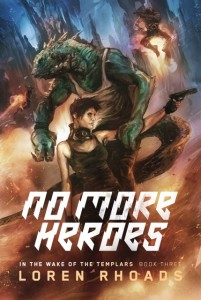Lore n Rhoads is the author of a new space opera trilogy — comprised of The Dangerous Type
n Rhoads is the author of a new space opera trilogy — comprised of The Dangerous Type, Kill by Numbers
, and No More Heroes
— all coming from Night Shade Books in 2015. She’s the co-author with Brian Thomas of a succubus/angel novel called As Above, So Below
. She authored a collection of travel essays from graveyards around the world called Wish You Were Here
: Adventures in Cemetery Travel and edited The Haunted Mansion Project: Year Two and Morbid Curiosity Cures the Blues: True Stories of the Unsavory, Unwise, Unorthodox and Unusual
. You can learn more at lorenrhoads.com.
I asked: Is there a literary heroine on whom you imprinted as a child? A first love, a person you wanted to become as an adult, a heroic girl or woman you pretended to be on the playground at recess? Who was she?
Loren: When I was 4, my parents moved out of town to a piece of land near the farm where my dad grew up. Our new house stood on what had been a wheat field. The low spot between two hills was bordered by a creek that tended to flood, so Dad borrowed a steam shovel and a dump truck to dig a pond farther back on the property. He used that dirt to fill in the area around the house. For several glorious months, the acre around the house was covered in random mounds of dirt, studded with wildflowers, weeds, and clumps of willows. It was the perfect setting to play Peter Pan.
At home, my younger brother let me pretend to be Peter. Once I started kindergarten that fall, my new friend Kirk insisted I be a girl. So I became Tiger Lily to his Captain Hook. To this day, I remember the excitement I felt, pretending to sit on Marooners’ Rock, my arms bound behind my back by imaginary ropes, waiting for my chance to escape the pirates.
Can you remember what it was she did or what qualities she had that captured your affections and your imagination so strongly?
As the chief’s daughter, Tiger Lily is basically a princess, but she wasn’t restricted to living indoors and learning needlework. The pirates caught her boarding the Jolly Roger with a knife in her teeth. For a girl like me, struggling not to be tamed by the public school system, she was the ideal role model.
How does she compare to the female characters in your work? Is she their literary ancestor? Do they rebel against all she stands for? What might your creations owe her?
The heroine of my trilogy, Raena Zacari, is definitely Tiger Lily all grown up. Raena is self-sufficient, stealthy, implacable, armed with knives, and hangs around with a band of media-obsessed pirates. I hadn’t drawn the connection between Raena and Tiger Lily until now.
How do you feel about the word heroine? In these posts, I am specifically looking for female authors’ female influences, whether those women they looked up to were other writers or Anne of Green Gables. Does the word heroine have a purpose that isn’t served by equally well by hero?
I grew up in an era of gendered language: actor/actress, steward/stewardess. I never felt that to be female was to be less than male, but I do sometimes think that women’s contributions are obscured beneath traditionally masculine terms like firefighter or hero. Strangely, I don’t see the gendering when it comes to terms like flight attendant or pilot or soldier, so perhaps I will come around to less gendered language in time.
Still, to answer your question, I prefer heroine. It’s important to me to call out the salient point of these characters as role models. Gender makes them more special, rather than less, probably because when I was young, there were so few adventure stories about girls. I want to celebrate their difference because for so long, I craved to see myself reflected.
About this post: The Heroine Question is my name for a series of short interviews with female writers about their favorite characters and literary influences. Clicking the link will allow you to browse all the other interviews, with awesome people like Marie Brennan, Alma Alexander, and Kelly Robson. Or, if you prefer something more in the way of an actual index, it’s here.



